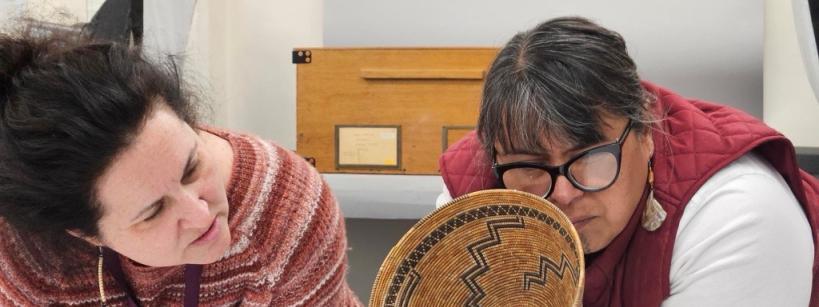By Timara Lotah Link (Shmuwich Chumash)
Holding our Chumash cultural items that are housed in the British Museum was breathtaking, brutal, and beautiful all at once. As a Chumash person, I grew up immersed in stories of our people, our lands, and the traditions we fight every day to keep alive. Yet, seeing these artifacts thousands of miles away from home in a country that colonized much of the world was a gut-wrenching reminder of how much has been taken from us. This trip to London wasn’t just a sightseeing venture; it was a pilgrimage to reconnect with fragments of my heritage—sing to the baskets, tell stories to the beads, remind the paddle what water sounds like. It was a chance to bring identity back to these displaced objects, so that the vague anthropology notes written about them could become rich, culturally detailed paragraphs on what they are used for, what plants they are made from, and what they are called in our languages.
As a weaver, I felt especially connected to the hands that wove the intricate designs into the baskets and the minds that dreamed up the stories behind them. Despite the distance and time, I could feel my roots stretching across oceans, refusing to be severed.
This visit to the British Museum left me with a strange mix of pride and pain. It reinforced the dual reality of being Indigenous in the modern world: the joy of rediscovering our past and the grief of understanding how much was taken. On the last day, as I placed the last basket into its paper box to sit in the silent halls it sleeps in—I made a silent promise to those objects and the ancestors behind them: that I would carry their stories forward in the best way I could. That I would honor them not just as relics of a stolen past but as threads of a living culture.
For anyone, Indigenous or not, who visits a museum to see objects like these, I urge you to look deeper. Don’t just admire the craftsmanship—ask about the journey of those artifacts. Who made them, and why? How did they get here? And most importantly, what can we do to ensure they’re honored, not just displayed?
Because for us, these are not just artifacts; they are pieces of our soul, waiting to be brought home.
Reclaiming El Camino
